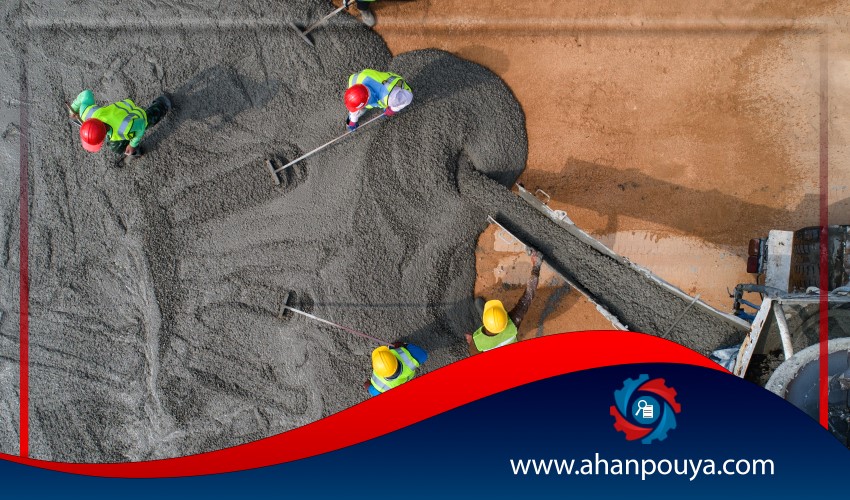
High-strength cement is produced by modifying the combined ratios of raw materials. This cement reaches its final strength in 24-72 hours.
The two main characteristics of high-strength cements are as follows.
1.Relatively fast-resistant cement contains more tricalcium silicate. This combination is achieved by adding a greater amount of limestone in cement raw materials than normal cement .
2.High-strength cement has a finer grain size than regular cement.
The above specifications make the complete hydration process faster and as a result, the concrete reaches its strength sooner.
In developed countries, high-strength cement is produced during the separation of the smallest particles (more than 700 square meters per kilogram) from the initial stages of making high-strength cement. this step is carried out by a special apparatus called the cyclone air elutriator.
In this type of cement, a small amount of heat is produced during concreting and hardening of concrete (hydration). this cement is used in large projects such as dam .
1.The ratio of dicalcium silicate or (C2S) is almost twice that of regular cement
2.The ratio of calcium tetraalumino ferrite (C4AlFe) has increased one to one and a half times.
3.The ratio of tricalcium silicate (C3S) and tricalcium aluminate (C3Al) has decreased by fifty percent. This change is due to the fact that the aforementioned substances produce a lot of heat when it comes to production .
The most important quality characteristics of low heat cement can be summarized as follows :
1.Grading : the remaining in the sieve test should not exceed 90 % .
2.Catch time : The initial setting time should not be less than 60 minutes and the final setting time should not be less than ten hours.
3.Resistance : Compressive strength should not be less than the following values.
a.70 kg per square centimeter in three days.
b.115 kg / cm2 in seven days.
c.265 kg / cm2 in twenty-eight days.
This cement is used in large projects such as dam construction. If ordinary Portland cement is used in these projects, cracks will develop on the concrete surface due to high heat during setting and hydration. A dam with cracks in its surface will be practically unusable. this type of cracks can be prevented by using low heat cement .
this type of cement is very resistant to early cement . The characteristic of fast setting cement is that this type of cement hardens like a rock mass in less than 30 minutes. This feature is achieved with the following controls in the manufacturing process.
1.The amount of retarding particles such as gypsum has decreased.
2.alumina - rich compounds have been reduced.
3.The clinker is the basis of this type of cement.
Fast setting cement is used in very special projects such as bridge piers and other structures built on water.
This type of cement has more than 40 % alumina compared to normal cement . High alumina cement is obtained by calculating a suitable mixture of lime and bauxite. No other soil, even gypsum, is added to the cement clinker when crushing and grinding.
1.this type of cement is resistant to corrosion and acid and salt of seawater.
2.The ratio of alumina to lime in this type of cement is between 0.85 to 1.3.
3.The compressive strength is 400 kg / cm in the first 24 hours .
4.This resistance reaches 500 kg / cm2 after 72 hours.
5.This type of cement produces a lot of heat during setting and is not suitable for large structures such as dams.
6.This type of cement has responded quickly with lime and should not be in contact with lime .
unfortunately , this type of cement has a high cost It is used in cases where corrosion resistance is required .
It is recommended to use this type of cement in projects near the coast.
This type of cement is a modified ordinary Portland cement with 25-65% (by weight) of kiln overhead ash.with the combination of clinker and special values of furnace overhead . A small percentage of gypsum is also added to control the setting time. Slag ash is a type of waste obtained from an iron furnace.
1.results in better performance , integration and better shape . This feature is justified by the lower specific gravity and specific surface area of most cement particles.
2.Better resistance to sulfates of alkali metals, alumina and iron.
3.Reduce heat generated during hydration.
4.The use of this type of cement is more economical than ordinary cement.
this type of cement is used in offshore structures such as quay walls . It is also used in the construction of roads with swampy and alkaline soils.
In this type of cement, clinker and pozzolanic materials such as volcanic ash and fly ash are combined in a certain ratio with Portland cement. pozzolanic materials don 't have any concrete properties alone But when combined with Portland cement, they react with cement components to form compounds with cement properties.
pozzolanic cement has the same properties with normal cement . However , other features are observed in this type of cement .
in this type of cement , color and cement will be combined into distinct ratios . the color used in this cement is powder and fine . Often a weight ratio of less than 10% of paint is used in the manufacture of this type of cement.
This type of cement is used for floor coverings and decorative purposes in construction.
In this type of cement, an additive is used that reduces the dependence of cement particles on water. This type of cement is used in special freezing conditions .
Waterproof cement is obtained by combining waterproof materials such as calcium and aluminum with ordinary cement during the cement production process. this type of cement is used in structures such as dam and water reservoirs .

Ahan Pouya with more than a decade of best-selling experience, adheres to professional and ethical principles in the field of selling and buying at inside and outside the borders of Iran, helping you in the steel industry.